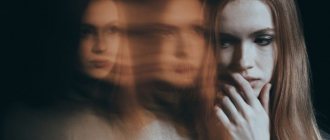Claustrophobia is a mental disorder characterized by the appearance of unreasonable fear in confined and cramped spaces. As a rule, this phobia manifests itself as attacks of fear while on a train, plane and other types of transport. Fear of being in a crowd is also a mixed type of claustrophobia and social phobia.
The cause of the fear of closed spaces may be mental trauma received in childhood.
Studies have shown that about 5% of the world's population has a severe form of this disorder, but only some patients seek help from a specialist. Like agoraphobia, it is one of the most common mental disorders related to phobias.
Claustrophobia is usually defined as an anxiety disorder that can lead to panic.
The cause of claustrophobia may be a genetic predisposition. Scientists have found that this disorder affects people who are afraid of monotony and prefer change, and people who are afraid of change are diagnosed with agoraphobia. Patients are frightened by the restriction of their freedom; they feel anxious when they are in a small room with few windows.
What is claustrophobia?
Claustrophobia is a psychopathological syndrome, the main manifestation of which is the fear of closed and/or cramped spaces. Among all phobias, it occupies a leading position. The name itself consists of the Latin “claustrum”, which means closed room, and the Greek “phobia”, which translates as fear.
Clinically, claustrophobia is accompanied by anxiety and fear when the patient enters a closed room, especially a cramped one, without windows or from which exit is difficult. Some people with this disorder cannot sit in an elevator, train compartment, car or airplane. In addition, panic can occur not only indoors, but also in any circumstances that restrict movement, for example, in a crowd, crowded transport, large crowds of people at the entrance or exit, queues, etc. Moreover, the forms of manifestation of a phobia can be of very different strength - from slight discomfort to panic attacks.
Many people don't even realize that they suffer from claustrophobia. For example, people usually explain the desire to always keep the door of their room open, the inability to sleep peacefully in a completely closed bedroom by the fact that it is difficult for them to breathe in a closed room. But in fact, a person lacks air precisely because of the unconscious fear of a closed space and the breathing disorder it causes. If the process does not progress, then this condition does not affect the quality of life in any way, but with increasing symptoms and the addition of new places and reasons for the occurrence of attacks of claustrophobia (elevator, car, etc.) it leads to significant restrictions on a person’s freedom of movement and communication. Sometimes the suffering becomes so severe that a person cannot enter a utility room or closet without locking the door in the open position, and he gets to work on foot, avoiding any transport. He cannot enter the subway, attend public events, etc. In this state, a person prefers to stay at home and do remote work. Constantly making sure to avoid closed, cramped or isolated rooms and places has a devastating effect on the psyche and can lead to severe depression. A person is almost always in tension and reacts in panic to any spatial restrictions. At the same time, he perfectly understands that the threat to his life and health is practically minimal, but he cannot cope with the fear that arises.
Types of violation
In psychotherapy, the following types of claustrophobia are distinguished on different grounds:
- depending on the severity of the attacks and the course of the disease - mild, moderate and severe forms;
- depending on the reasons - hereditary, primary and secondary;
- depending on the dominant fear: fear of suffocation or fear of limited space.
The main direction of treatment will depend on the type.
According to data, about 5-7% of the world's population suffers from severe claustrophobia.
What are the causes of claustrophobia?
The causes of claustrophobia lie in genetic memory and psychological trauma experienced in childhood or in adulthood. Adherents of evolutionary theory explain the fear of closed spaces by the genetic memory of our ancestors, who were afraid to be in caves with a narrow entrance or cramped manholes, where they escaped from wild animals. The possibility of a collapse, closing the entrance or a tight passage caused fear of suffocation, practically being buried alive. This fear was so strong that it became entrenched at the genetic level and, under certain circumstances, is activated in modern humans. Proponents of the theory of psychological trauma believe that difficulty breathing, restriction of freedom of movement and exit, associated with a threat to life and experienced by a person at least once, can lead to claustrophobia. Some scientists believe that even the suffering of the fetus when passing through the birth canal can later cause a fear of closed spaces, labyrinths and tunnels.
Approximately 5 to 10% of the population suffers from some form of claustrophobia, with the vast majority developing it during childhood. Most often occurs in a child who has had such sad experiences in the past as: • Being in a dark room from which he cannot find a way out or turn on the light. Therefore, there is no way to justify parents who use locking their child in a closed, especially dark and cramped room as punishment. Such rash actions can subsequently become the cause of the development of many psychopathologies and, first of all, claustrophobia. • Inability to find a way out of the mirror maze when attending entertainment events. • Accidentally found himself locked in a closet and drawer. • Falling into a deep pool if you cannot swim. Therefore, you should not teach a child to swim by throwing him into the deep and expecting him to swim on his own, following his instinct. Even if you insure it, the horror of drowning can leave an indelible impression for the rest of your life and lead to claustrophobia. • If the child gets stuck in the bars of a bed or fence, especially if his head is stuck. • When parents lose a child in a large crowd. • If the baby is left alone in a car or van.
I have listed the most typical situations, but parents should always be vigilant and come to the aid of their child if he suddenly finds himself in an uncomfortable, and even more dangerous, situation. For example, when the light in a closed room is suddenly turned off at night, you must immediately come to the rescue. Feeling your presence, especially with a flashlight, the baby will certainly calm down and will not have time to experience all the horror of being alone in a closed room, from which he cannot find a way out. The most common sites for claustophobia attacks are those in which there is a fear of restraint or suffocation. These may include: • Isolated areas, locked or cramped rooms. • CT and MRI machines. • Cars, buses, trains, airplanes and other means of transportation (elevators) of a closed type or without the possibility of free exit. • Basements, tunnels, caves. • Chair for hairdresser, dentist. Moreover, the dentist’s panic arises not so much from fear of pain, but from fear of limitation. • A large crowd or queue at the store, at the ticket office, as well as crowds of people in the narrow corridors of clinics, social institutions, etc.
In general, it can be argued that claustrophobia is an evolutionarily prepared (programmed), biologically significant (relating to safety and survival), as well as a non-cognitive (unconscious) phobia. It is easily provoked, stable and uncontrollable by consciousness.
In addition, the cause of claustrophobia can be not only one’s own psychological trauma and past experience, but also the sight of people in an extreme situation. For example, a person squeezed into a car during an accident or victims of an elevator fall. Even an overly colorful story about the feelings of a person who has experienced being in a confined space (searching for a way out of a cave labyrinth, waiting for many hours to be released from a stuck elevator, etc.) can become an impetus for the development of claustrophobia.
An etiological factor in the development of a phobia can also be organic damage to the so-called amygdala, a small but significant structure of the brain responsible for the formation of fear and a person’s fight-or-flight response to a threat. The reaction to fear is accompanied by an increased release of adrenaline, which determines the entire symptom complex of autonomic failure. A decrease in the right lobe of the amygdala was noted in patients with panic disorders and any phobias, including claustrophobia. Most often, attacks of fear of closed spaces first appear at the age of 25-35 and the frequency of their occurrence decreases after 50. In children, claustrophobia is less common and more easily treated. Women are more susceptible to it than men, perhaps due to their emotional lability and impressionability.
General description of the disease
Claustrophobia is the fear of cramped, enclosed spaces (elevators, fitting rooms in clothing stores, train compartments, etc.). Anxiety arises against a person’s will (although the patient usually realizes that it is completely unfounded), therefore all attempts to explain to him the irrationality of his behavior are futile. The disease manifests itself at any age, but it is more common in adolescents and young adults.
Causes
The main etiological factor is considered to be severe psychotrauma (especially at an early age) associated with the content of the phobia. This is for example:
- long stay in a dark, closed room;
- natural disaster, accident (for example, claustrophobia was often diagnosed in earthquake victims);
- physical and emotional abuse;
- fears formed in a child after reading any books, watching films not intended for his age, etc.
What symptoms occur during an attack of claustrophobia?
The main symptom of an attack is irrational fear, which the patient practically cannot resist, although he realizes that the danger to him in this situation is minimal. It is accompanied by the following autonomic symptoms: • Tachycardia (rapid and increased heartbeat). • Breathing disorders - it becomes more frequent and is accompanied by a feeling of lack of air. • Trembling – the patient literally shakes with fear. • Increased sweating. • Dizziness with lightheadedness.
These symptoms may also be accompanied by abdominal discomfort in the form of nausea, pain in the epigastric region, and gastrointestinal spasms. This is reminiscent of the so-called “bear disease” (irritable bowel syndrome), often triggered by severe stress. Autonomic failure can be so severe that it can lead to dangerous arrhythmias, temporary cessation of breathing (patients feel as if they have stopped breathing) and even loss of consciousness.
Treatment
Is there a cure for claustrophobia? Yes, modern psychotherapeutic techniques can relieve this mental disorder in a few sessions. There is information that an experienced specialist can do this in 6-7 hours.
Drug therapy
In advanced conditions, drug treatment with the following drugs is prescribed:
Psychotherapeutic
Psychotherapeutic treatment is represented by the following areas and techniques:
Additionally:
- acquisition of relaxation skills;
- physical stress management training;
- classes on the ability to block negative thoughts.
If claustrophobia is left untreated, the symptoms will only worsen and the disorder will become chronic. Prolonged depression develops, accompanied by lethargy, apathy and voluntary social isolation.
The peak of claustrophobia occurs between 25 and 45 years. It is rare in childhood, and after 50 it weakens.
Diagnostics
Photo: clinicist.ru
Determining whether a person has claustrophobia is based on identifying the symptoms characteristic of this condition. A detailed survey of the patient is carried out, the nature of his sensations and objective manifestations that arise when he is in a confined space is clarified.
It is important to be able to distinguish claustrophobia from certain individual character traits. For example, for some people, the fear of being in a cramped room in the presence of other people is associated with self-doubt, shyness, and an inferiority complex. Also, avoiding being on public transport or other crowds of people may be associated with a mental disorder. Such fear of being in the same room with other people will be associated with the patient having delusions of persecution or delusions of relation. Therefore, it is extremely important to be able to distinguish true claustrophobia from the fear of being in small rooms with crowds of people in other human conditions.
It should be borne in mind that constant fear a person experiences can lead to depressive disorder. When talking with a patient, the doctor must remember about this possibility of events, so it is recommended to treat these patients with special care so as not to miss the first symptoms of depression, thereby preventing irreversible consequences.
Folk remedies
Photo: glaznoy-doctor.ru
A person suffering from claustrophobia can independently learn various methods of relaxation, which are indispensable when acute attacks of phobia suddenly occur. If you feel an attack approaching and understand that it is impossible to avoid it, it is recommended to try to relax as much as possible. You should concentrate your gaze on a specific object that is at eye level. You should not frantically look around in search of a way out, as this increases panic and contributes to the growth of fear. It is also important to breathe properly, inhaling air deeply through your nose.
There are physical exercises that promote muscle relaxation. The Jacobson method of muscle relaxation is considered the most popular at the moment. The exercises are designed in such a way that during their implementation, alternating states of tension and relaxation of individual muscle groups occur. The author of this technique, while conducting research on human emotions, discovered a direct connection between a person’s emotional state and muscle tension. Based on this, a theory was put forward that muscle relaxation helps relieve nervous tension and stabilize a person’s emotional background. The exercises proposed by the author are quite simple, so anyone interested in this technique can easily study the list of exercises in a fairly short time. In a stressful situation, using this relaxation method helps to calm down, relieve neuromuscular tension and gain control over your emotions, which is especially important for people with a phobia.
To stabilize your mood, you can use various herbal decoctions that have a calming effect. The following herbs have this property: peppermint, lemon balm, valerian, chamomile, St. John's wort and many others. You can purchase a ready-made collection of herbs at the pharmacy or prepare your own tea at home using any of the listed herbs that have a calming effect. These teas not only improve your mood, but also normalize sleep, reduce irritability and nervousness, relieve fatigue and increase performance.
The information is for reference only and is not a guide to action. Do not self-medicate. At the first symptoms of the disease, consult a doctor.
Medicines
Photo: zena.cz
For claustrophobia, courses of taking tranquilizers are prescribed. These drugs have the following effects:
- anti-anxiety (their main effect is to reduce anxiety, fear, restlessness, and eliminate obsessive thoughts);
- vegetostabilizing (consists of reducing vegetative manifestations of anxiety (tachycardia, increased blood pressure, increased sweating, gastrointestinal disorders));
- sedative (calming effect, which, unfortunately, is accompanied by decreased concentration and lethargy);
- muscle relaxant (relaxes the muscles, which is accompanied by a feeling of general weakness and lethargy);
- sleeping pills (accelerates the onset of sleep, increases the depth and duration of sleep).
These drugs are prescribed by a doctor in a course of 2–3 weeks of continuous use. Long-term use of benzodiazepine tranquilizers is not recommended, as dependence may develop. Therefore, if a person still needs to take these drugs for a long time, after the course, they should stop taking the drugs for a while, and then repeat the next course of use. In addition, withdrawal syndrome, which can develop during abrupt withdrawal of tranquilizers, is prevented by gradually reducing the dose and increasing the interval between doses. Contraindications to the prescription of tranquilizers are: liver and respiratory failure, ataxia, glaucoma, myasthenia gravis. Side effects that occur while taking tranquilizers include: drowsiness, general weakness, lethargy, decreased concentration and short-term memory, decreased blood pressure, constipation, nausea, urinary retention or incontinence. Considering all the nuances of these drugs, it is necessary to strictly follow all doctor’s prescriptions.
Antidepressants are prescribed to improve a person's mood and general mental state. The development of the expected effect does not occur immediately after starting to take the drugs, but after approximately 10 days. This is explained by the fact that the development of the antidepressant effect is associated with the accumulation of neurotransmitters in the area of nerve endings and with the slow development of adaptation mechanisms in the circulation of neurotransmitters. As a result, antidepressants are prescribed in a course of continuous use for 3–6 months, during which time the desired effect is gradually achieved.









